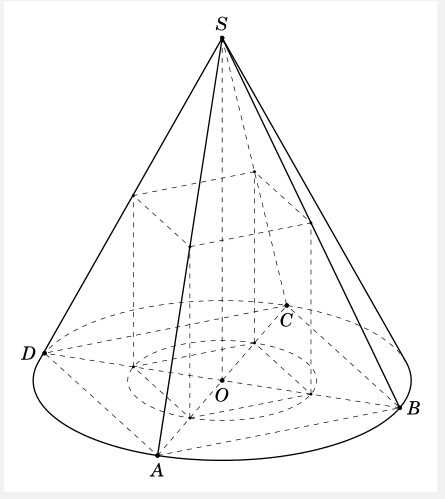I am trying to draw a rectangular parallelepiped is inscribed in a right circular cone. My code
```
\documentclass[border=2mm,12pt,tikz]{standalone}
\usepackage{fouriernc}
\usepackage{tikz-3dplot}
\usetikzlibrary{calc,backgrounds}
\begin{document}
%polar coordinates of visibility
\pgfmathsetmacro\th{65}
\pgfmathsetmacro\az{110}
\tdplotsetmaincoords{\th}{\az}
%parameters of the cone
\pgfmathsetmacro\R{5} %radius of base
\pgfmathsetmacro\v{2*\R} %hight of cone
\pgfmathsetmacro\a{3}
\pgfmathsetmacro\b{4}
\pgfmathsetmacro\r{{1/2*sqrt(\a*\a+\b*\b)}}
\pgfmathsetmacro\h{(\R-\r)*\v/\R}
\begin{tikzpicture} [scale=0.8, tdplot_main_coords]
\begin{scope}[canvas is xy plane at z=0]
\path
coordinate (O) at (0,0)
coordinate (A) at (\R,0)
coordinate (B) at (0,\R)
coordinate (C) at (-\R,0)
coordinate (D) at (0,-\R,0)
coordinate (M) at (\r,0)
coordinate (N) at (0,\r)
coordinate (P) at (-\r,0)
coordinate (Q) at (0,-\r);
\end{scope}
\begin{scope}[canvas is xy plane at z=\h]
\path coordinate (M') at (\r,0)
coordinate (N') at (0,\r)
coordinate (P') at (-\r,0)
coordinate (Q') at (0,-\r)
;
\end{scope}
\coordinate (S) at (0,0,\v);
\foreach \v/\position in {O/below,A/below, B/right, C/below, D/left, S/above} {\draw[draw =black, fill=black] (\v) circle (1.5pt) node [\position=0.2mm] {$\v$};
}
\foreach \X in {A,B} \draw[thick] (\X) -- (S);
\foreach \X in {M,N,P,Q} \draw[dashed] (\X) -- (\X');
\draw[dashed] (A) -- (B) -- (C) -- (D) -- cycle
(M) -- (N) -- (P) -- (Q) -- cycle
(M') -- (N') -- (P') -- (Q') -- cycle
(A) -- (C) (B) -- (D)
(S)--(O) (S)-- (C);
\foreach \Y in {M, N, P, Q, M', N', P', Q'}
\fill (\Y) circle[radius=1.1pt];
\begin{scope}[canvas is xy plane at z=0]
\draw[dashed] (O) circle[radius=\r];
\end{scope}
\pgfmathsetmacro\cott{{cot(\th)}}
\pgfmathsetmacro\fraction{\R*\cott/\v}
\pgfmathsetmacro\fraction{\fraction<1 ? \fraction : 1}
\pgfmathsetmacro\angle{{acos(\fraction)}}
% % angles for transformed lines
\pgfmathsetmacro\PhiOne{180+(\az-90)+\angle}
\pgfmathsetmacro\PhiTwo{180+(\az-90)-\angle}
% % coordinates for transformed surface lines
\pgfmathsetmacro\sinPhiOne{{sin(\PhiOne)}}
\pgfmathsetmacro\cosPhiOne{{cos(\PhiOne)}}
\pgfmathsetmacro\sinPhiTwo{{sin(\PhiTwo)}}
\pgfmathsetmacro\cosPhiTwo{{cos(\PhiTwo)}}
% % angles for original surface lines
\pgfmathsetmacro\sinazp{{sin(\az-90)}}
\pgfmathsetmacro\cosazp{{cos(\az-90)}}
\pgfmathsetmacro\sinazm{{sin(90-\az)}}
\pgfmathsetmacro\cosazm{{cos(90-\az)}}
% % draw basis circle
\tdplotdrawarc[tdplot_main_coords,thick]{(O)}{\R}{\PhiOne}{360+\PhiTwo}{anchor=north}{}
\tdplotdrawarc[tdplot_main_coords,dashed]{(O)}{\R}{\PhiTwo}{\PhiOne}{anchor=north}{}
% % displaying tranformed surface of the cone (rotated)
\draw[thick] (0,0,\v) -- (\R*\cosPhiOne,\R*\sinPhiOne,0);
\draw[thick] (0,0,\v) -- (\R*\cosPhiTwo,\R*\sinPhiTwo,0);
\end{tikzpicture}
\end{document}
```

How to draw this picture by another way?
This code recycles the `cone` pic from another answer. In order to decide whether the edges from a point `A`, `B`, `C`, or `D` to `S` are visible or hidden, we compute the normal on the cone at these points. The normal is given by the vector product of the tangent at the base circle and the respective edge. The tangent is simply given by the vector product of the point and `(0,0,1)`.
```
\documentclass[tikz,border=3mm]{standalone}
\usepackage{tikz-3dplot}
\usetikzlibrary{3dtools}
\tikzset{pics/3d/cone/.style={code={
\tikzset{3d/cone/.cd,#1}
\def\pv##1{\pgfkeysvalueof{/tikz/3d/cone/##1}}%
\pgfmathsetmacro{\sdtip}{screendepth(0,0,\pv{h})}
\pgfmathsetmacro{\aspectangle}{atan2(\sdtip,sqrt(\pv{h}*\pv{h}-\sdtip*\sdtip))}
\path (0,0,\pv{h}) coordinate (-tip);
\begin{scope}[x={(0,0,tan(\aspectangle))},y={($(0,0,0)!1cm!90:(0,0,\pv{h})$)}]
\pgfmathtruncatemacro{\itest}{abs(tan(\aspectangle)*\pv{r}/\pv{h})<1}
\ifnum\itest=1
\pgfmathsetmacro{\alphacrit}{acos(tan(\aspectangle)*\pv{r}/\pv{h})}
\ifdim\sdtip pt>0pt
\path[/tikz/3d/cone/hidden] (\alphacrit:\pv{r}) arc[start angle=\alphacrit,end
angle=-\alphacrit,radius=\pv{r}];
\path[/tikz/3d/cone/visible] (\alphacrit:\pv{r})
arc[start angle=\alphacrit,end angle=360-\alphacrit,radius=\pv{r}]
-- (-tip) -- cycle;
\else
\path[/tikz/3d/cone/visible] circle[radius=\pv{r}];
\path[/tikz/3d/cone/visible] (\alphacrit:\pv{r})
-- (-tip) -- (360-\alphacrit:\pv{r});
\fi
\else
\path[/tikz/3d/cone/visible] circle[radius=\pv{r}];
\fi
\end{scope}
}},
3d/cone/.cd,r/.initial=1,h/.initial=1,
hidden/.style={draw,very thin,densely dashed},
visible/.style=draw}
\begin{document}
\foreach \Angle in {5,15,...,355}
{\begin{tikzpicture}[visible/.style={draw,solid},
hidden/.style={draw,very thin,densely dashed},
declare function={
R=5;% radius of the base of the cone
v=2*R;% height
a=3;
b=4;
r=0.5*sqrt(a*a+b*b);
h=(R-r)*v/R;
}]
\tdplotsetmaincoords{65}{\Angle}
\begin{scope}[tdplot_main_coords]
\pic{3d/cone={r=R,h=v}};
\path
(0,0,0) coordinate (O)
(R,0,0) coordinate (A)
(0,R,0) coordinate (B)
(-R,0,0) coordinate (C)
(0,-R,0) coordinate (D)
(r,0,0) coordinate (M)
(0,r,0) coordinate (N)
(-r,0,0) coordinate (P)
(0,-r,0) coordinate (Q)
(r,0,h) coordinate (M')
(0,r,h) coordinate (N')
(-r,0,h) coordinate (P')
(0,-r,h) coordinate (Q')
(0,0,v) coordinate (S);
\draw[hidden] (A) -- (B) -- (C) -- (D) -- cycle (A) -- (C) (B) -- (D)
(M) -- (N) -- (P) -- (Q) -- cycle
(M') -- (N') -- (P') -- (Q') -- cycle
foreach \X in {P,Q,M,N} {(\X) -- (\X')}
(O) circle[radius=r];
\foreach \X in {A,B,C,D}
{\pgfmathsetmacro{\myT}{TD("(0,0,1)x(\X)")}% tangent
\pgfmathsetmacro{\myN}{TD("(\myT)x(S)-(\X)")}% normal
\pgfmathtruncatemacro{\itest}{sign(screendepth(\myN))}
\ifnum\itest=-1
\draw[hidden] (\X) -- (S);
\else
\draw[visible] (\X) -- (S);
\fi
}
\end{scope}
\end{tikzpicture}}
\end{document}
```
